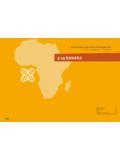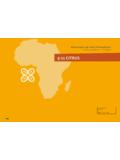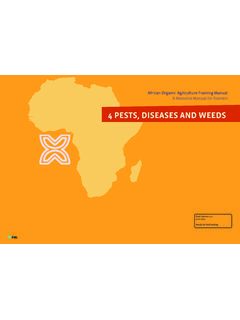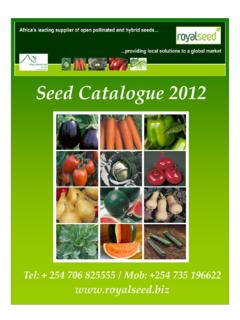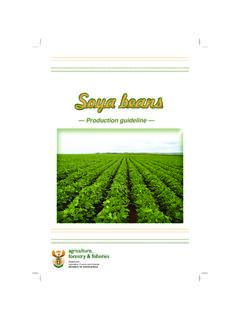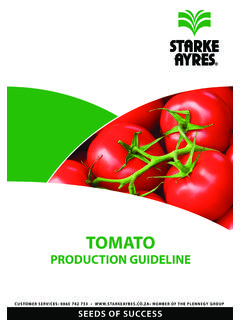Transcription of African Organic Agriculture Training Manual - Beans
1 9-8 BEANSA frican Organic Agriculture Training ManualA Resource Manual for TrainersDraft Version 2011 Ready for field testingAfrican Organic Agriculture Training Manual Module 09 Crops: Unit 8 BeansCONTENTS1. Introduction 12. Proper selection of planting materials 43. Proper field establishment 84. Improving postharvest handling 145. Organic certification of bean production 15 IMPRINTP ublisher:FiBL, Research Institute of Organic Agriculture , Switzerland, :> IFOAM, International Federation of Organic Agriculture Movements, Germany, > NOGAMU, National Organic Agricultural Movement of Uganda, > FENAB, Senegal> OPPAZ, Organic Producers and Processors Association of Zambia, author: Paul van der Berge (FiBL) Reviewer: Brian SsebunyaIllustrator:Okudi Deogratius GerardDraft version , September 2011. This is an interim version. Comments and recom-mendations for improvement are Manual chapter can be reproduced without permission.
2 All materials resulting from the Africa Organic Agriculture Training Manual project are available free of charge in the internet under production of this Manual was funded by the Bill and Melinda Gates Foundation and the Syn-genta Foundation for Sustainable Agriculture with the goal to promote Organic farming in the information contained in this Manual has been compiled by the authors to the best of their knowledge. Reasonable efforts have been made by the Research Institute of Organic Agriculture and their partners to publish reliable data and information. The authors, the editors and the pub-lishers cannot assume responsibility for the valid-ity of the materials. Neither the authors, nor the publishers, nor anyone else associated with this publication, shall be liable for any loss, damage or liability directly or indirectly caused or alleged to be caused by the Training Manual and its African Organic Agriculture Training Manual is based on research funded by the Bill & Melinda Gates Foundation and the Syngenta Foundation for Sustainable Agriculture .
3 The Manual s findings, conclusions and recommendations are those of the authors, and do not necessarily reflect posi-tions or policies of either cite this publication as follows: FiBL (2011): African Organic Agriculture Training Manual . Version June 2011. Edited by Gilles Weidmann and Lukas Kilcher. Research Institute of Organic Agriculture FiBL, FrickISBN 978-3-03736-197-9 African Organic Agriculture Training Manual Module 09 Crops: Unit 8 Beans 19-8 BEANSL earning targets for farmers: >Learn good production practices of Beans >Understand procedure for selecting the most adaptable varieties >Recognize possibilities for proper integration of Beans in the local farming systems >Learn Organic approaches to pest, disease and weed management >Learn the main requirements for Organic certification of bean production1 Introduction Common Beans (Phaseolus vulgaris) belong to the very large family of Fabaceae (also called Leguminoseae), which includes food plants such as Beans , peas, pulses, peanuts and soybeans.
4 This chapter, however, will focus on the common Beans important food crops from the Fabaceae family are:Genus: Phaseolus ( Beans )Common bean Phaseolus vulgarisRunner bean (scarlet bean)Phaseolus coccineusAzuki beanPhaseolus angularisLima bean (Butter bean)Phaseolus lunatusGreen gram (Mung bean)Phaseolus aureusGenus: Viceaceae (vetches)PeaPisum sativumBroad beanVicia fabaLentilLens culinarisChickpeaCicer arietinumCowpeaVigna sesquipedalisGenus: GlycineSoybeanGlycine maxDaM IMaxIME CuM IPISTIa TEMPORERIaM EVENTuR SEFaCTShEET 8: Beans African Organic Agriculture Training Manual Module 09 Crops: Unit 8 Beans 2 AAhOw TO RECOGNIzE RhIzO-bIuM NODuLES ON ThE ROOT OF LEGuMES Common Beans (Phaseolus vulgaris) can be differentiated into:a. Dry Beans and green Beans - Common Beans can be grown as dry (shelled) Beans or green Beans (also called French or haricot Beans ), whereby green Beans are the unripe pods of common Beans .
5 Varieties suitable for shelling usually have larger seeds and bigger pods and the shelled seeds can be eaten either fresh or dried. Green Beans have fleshy pods and should be harvested before the seeds are fully developed. b. Indeterminate (climbing) and determinate (bush) Beans - The indetermi-nate growth of climbing Beans refers to growth that is not terminated while bush Beans grow to approximately 50 cm and can be grown without support. Climbing Beans are usually grown on a trellis and can easily grow 3 meters high or more. Because of the bigger plant volume, they have a higher yield potential than bush Advantages of incorporating Beans into a cropping systemAn important characteristic of Beans , like other legumes too, is their ability to transform atmospheric nitrogen into nitrogen that can be taken up by plants. They do this with the help of Rhizobium bacteria that live in their roots.
6 This property makes Beans (and other legumes) an important element in crop rotations. They provide nitrogen not only for themselves, but also for the crops that reasons to grow Beans on small and medium sized farms are manifold: > Beans , like other legumes, are a rich source of protein, carbohydrates, miner-als and vitamins. Protein content in Beans can reach up to 40 %, whereas the protein content of meat is approximately 20 % only. > Beans are an important staple food in rural Africa and grown widely, only sec-ond to maize. > Beans are relatively easy to grow on small pieces of land. > Beans fit in very well into crop rotations and provide nitrogen to the crop that follows. > Beans can be successfully intercropped with crops like maize or cassava. >Dry Beans can be stored and consumed or sold on the market according to need. > Beans have big demand in both domestic and regional markets within Organic Agriculture Training Manual Module 09 Crops: Unit 8 Beans 3 Discussion on assessment of the local bean pro- duction situation To assess challenges in local bean production ask the farmers the following questions: >Are you familiar with bean production?
7 >Do you experience any of the above or other challenges? >How have you tried to address those chal-lenges?ChaLLENGES FaCING baNaNa PRODuCTION Challenges related to bean production in AfricaDespite all of the above mentioned benefits, bean production still faces a number of challenges in Africa: >Poor selection of bean seeds - Although many farmers face difficulties in find-ing good yielding varieties suitable to local conditions, the handling of varie-ties is also very poor. Normally farmers mix up improved and local varieties in the same gardens, making it difficult to achieve full potential from improved varieties. The harvested Beans are further mixed up after shelling and dur-ing further planting. As a result of cross pollination, the characteristics of im-proved varieties are gradually lost. >Poor quality of seeds - Since virus infection of bean crops is widespread, the bean seeds farmers use for growing the next crop are often virus infested.
8 >Soil degradation - Bean production in Africa is severely constrained by low soil fertility. In Central and Eastern Africa, the major soil fertility related prob-lems include low available Nitrogen (N) and Phosphorus (P) and soil acidity. Many areas have acid soils poor in nutrients while others are too arid for bean production. Soil erosion is another problem, especially in highland areas. >Poor husbandry practices - Difficulties in finding suitable material for making a trellis for climbing Beans limits the full productive potential of these Beans . >Postharvest losses - Especially during drying and storage, a significant amount of Beans is lost through mould. This is a result of insufficient dry-ing and the exposure of the dried Beans to water or humidity during storage. Poor sorting of Beans is another quality problem. Different varieties, sizes, stones and other waste from threshing are always found mixed with the Beans presented to the market for aim of this chapter is to introduce Organic approaches that can be adopt-ed according to the local conditions, in order to support a more sustainable and profitable production of Beans .
9 TyPICaL bEaN PRODuCTION SITuaTION IN aFRICaIMPROVED bEaN PRODuCTION African Organic Agriculture Training Manual Module 09 Crops: Unit 8 Beans 4AA Sharing experi-ences on available bean varieties in the areaTo determine which types and varieties of Beans are locally grown, ask the farmers the following questions: >Which types of Beans are commonly grown in the area, green or dry Beans ? >Are there any new varieties that have been promoted in the area? >How are the new varie-ties performing under local conditions? >What do you consider when choosing bean varieties to plant?2 Proper selection of planting materialsCommon Beans come in a tremendous variety; the pods can be green, yellow, purplish brown or striped and the seed colour varies from white to brown or black, red, striped, mottled or multicoloured. The main varieties for dry Beans are Calima, Reds, Navy Bean, Cream Coloured, Brown and Yellow Coloured, Purple Beans , Medium Whites, Large Whites and large number of varieties makes it difficult to decide which varieties to grow.
10 Some of the varieties are indigenous while others are improved and each has its own traits. It is, therefore, necessary that a farmer identify a selected number of varieties that have been observed to be superior with respect to cer-tain traits under local production Choice of suitable varietiesThe choice of the right variety depends on the market requirements, local grow-ing conditions and the availability and quality of Market requirements >Multipurpose varieties: Varieties grown primarily for self-sufficiency are those that can be eaten as fresh green Beans , fresh or dried seeds, and some-times also the leaves. Multipurpose varieties are usually climbing Beans or runner Beans that can be harvested over a longer period of time. >Green Beans : In densely populated areas and those near towns, the demand for fresh green Beans is high. Farmers can grow fresh green Beans for the market.


